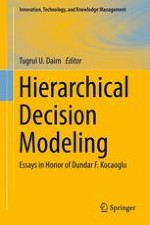2016 | OriginalPaper | Chapter
9. National Technology Planning: A Case Study on the Biopharmaceutical Industry in China
Authors : Leong Chan, Tugrul U. Daim, Dundar F. Kocaoglu
Published in: Hierarchical Decision Modeling
Publisher: Springer International Publishing
Activate our intelligent search to find suitable subject content or patents.
Select sections of text to find matching patents with Artificial Intelligence. powered by
Select sections of text to find additional relevant content using AI-assisted search. powered by
